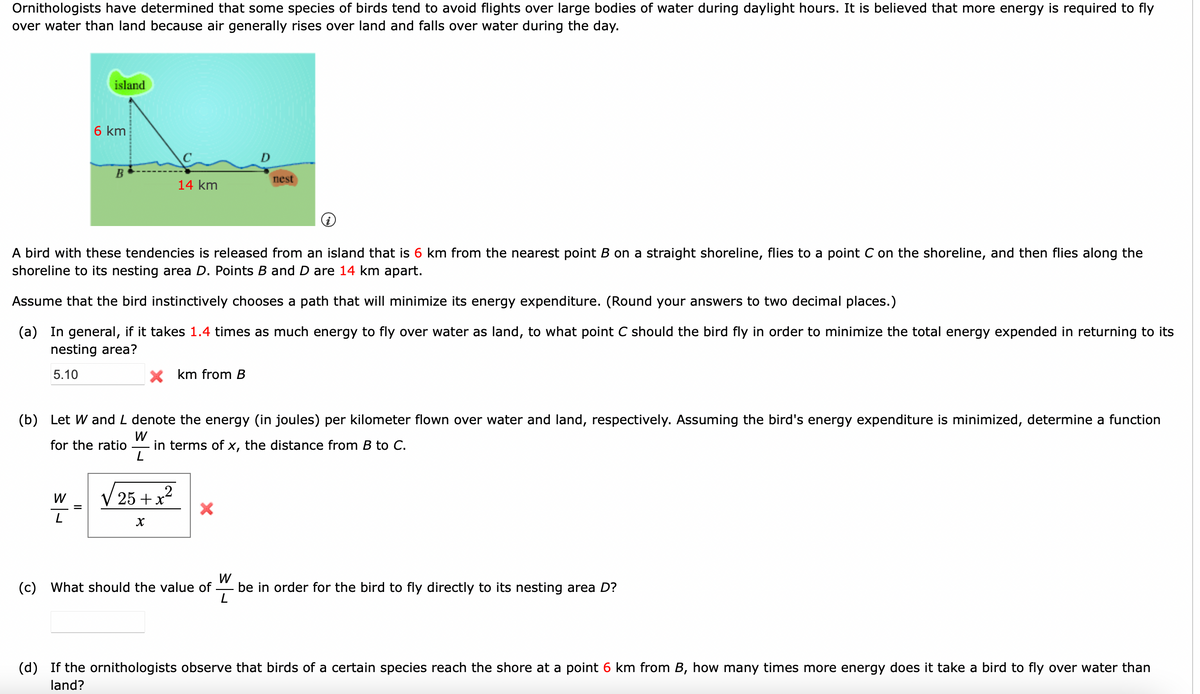Ornithologists have determined that some species of birds tend to avoid flights over large bodies of water during daylight hours. It is believed that more energy is required to fly over water than land because air generally rises over land and falls over water during the day. island 6 km B nest 14 km A bird with these tendencies is released from an island that is 6 km from the nearest point B on a straight shoreline, flies to a point C on the shoreline, and then flies along the shoreline to its nesting area D. Points B and D are 14 km apart. Assume that the bird instinctively chooses a path that will minimize its energy expenditure. (Round your answers to two decimal places.) (a) In general, if it takes 1.4 times as much energy to fly over water as land, to what point C should the bird fly in order to minimize the total energy expended in returning to its nesting area? 5.10 x km from B (b) Let W and L denote the energy (in joules) per kilometer flown over water and land, respectively. Assuming the bird's energy expenditure is minimized, determine a function for the ratio in terms of x, the distance from B to C. V 25 + x? (c) What should the value of be in order for the bird to fly directly to its nesting area D? (d) If the ornithologists observe that birds of a certain species reach the shore at a point 6 km from B, how many times more energy does it take a bird to fly over water than land?
Ornithologists have determined that some species of birds tend to avoid flights over large bodies of water during daylight hours. It is believed that more energy is required to fly over water than land because air generally rises over land and falls over water during the day. island 6 km B nest 14 km A bird with these tendencies is released from an island that is 6 km from the nearest point B on a straight shoreline, flies to a point C on the shoreline, and then flies along the shoreline to its nesting area D. Points B and D are 14 km apart. Assume that the bird instinctively chooses a path that will minimize its energy expenditure. (Round your answers to two decimal places.) (a) In general, if it takes 1.4 times as much energy to fly over water as land, to what point C should the bird fly in order to minimize the total energy expended in returning to its nesting area? 5.10 x km from B (b) Let W and L denote the energy (in joules) per kilometer flown over water and land, respectively. Assuming the bird's energy expenditure is minimized, determine a function for the ratio in terms of x, the distance from B to C. V 25 + x? (c) What should the value of be in order for the bird to fly directly to its nesting area D? (d) If the ornithologists observe that birds of a certain species reach the shore at a point 6 km from B, how many times more energy does it take a bird to fly over water than land?
Trigonometry (MindTap Course List)
8th Edition
ISBN:9781305652224
Author:Charles P. McKeague, Mark D. Turner
Publisher:Charles P. McKeague, Mark D. Turner
Chapter3: Radian Measure
Section: Chapter Questions
Problem 1RP
Related questions
Question

Transcribed Image Text:Ornithologists have determined that some species of birds tend to avoid flights over large bodies of water during daylight hours. It is believed that more energy is required to fly
over water than land because air generally rises over land and falls over water during the day.
island
6 km
nest
14 km
A bird with these tendencies is released from an island that is 6 km from the nearest point B on a straight shoreline, flies to a point C on the shoreline, and then flies along the
shoreline to its nesting area D. Points B and D are 14 km apart.
Assume that the bird instinctively chooses a path that will minimize its energy expenditure. (Round your answers to two decimal places.)
(a) In general, if it takes 1.4 times as much energy to fly over water as land, to what point C should the bird fly in order to minimize the total energy expended in returning to its
nesting area?
5.10
X km from B
(b) Let W and L denote the energy (in joules) per kilometer flown over water and land, respectively. Assuming the bird's energy expenditure is minimized, determine a function
W
in terms of x, the distance from B to C.
L
for the ratio
V 25 + x?
W
%3D
W
be in order for the bird to fly directly to its nesting area D?
L
(c) What should the value of
(d) If the ornithologists observe that birds of a certain species reach the shore at a point 6 km from B, how many times more energy does it take a bird to fly over water than
land?
Expert Solution
This question has been solved!
Explore an expertly crafted, step-by-step solution for a thorough understanding of key concepts.
This is a popular solution!
Trending now
This is a popular solution!
Step by step
Solved in 3 steps with 1 images

Recommended textbooks for you

Trigonometry (MindTap Course List)
Trigonometry
ISBN:
9781305652224
Author:
Charles P. McKeague, Mark D. Turner
Publisher:
Cengage Learning

Algebra & Trigonometry with Analytic Geometry
Algebra
ISBN:
9781133382119
Author:
Swokowski
Publisher:
Cengage

Glencoe Algebra 1, Student Edition, 9780079039897…
Algebra
ISBN:
9780079039897
Author:
Carter
Publisher:
McGraw Hill

Trigonometry (MindTap Course List)
Trigonometry
ISBN:
9781305652224
Author:
Charles P. McKeague, Mark D. Turner
Publisher:
Cengage Learning

Algebra & Trigonometry with Analytic Geometry
Algebra
ISBN:
9781133382119
Author:
Swokowski
Publisher:
Cengage

Glencoe Algebra 1, Student Edition, 9780079039897…
Algebra
ISBN:
9780079039897
Author:
Carter
Publisher:
McGraw Hill